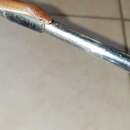en
names in breadcrumbs


Die Kaapse wolfslang (Lycophidion capense) is 'n onskadelike slang wat wydverspreid oor Suidelike Afrika voorkom behalwe in die Wes-Kaap waar dit net aan die suidelike kus en net in die noorde van die Noord-Kaap voorkom. Die slang het sy naam verkry weens die lang, teruggebuigde voortande aan albei kake.
Die slang se rug is lig tot donkerbruin of swarterig. Soms het die skubbe witrande wat die die slan gespikkel laat voorkom. Die pens is normaalweg wit, daar is soms donker spikkels op die op die pens. Daar kan ook soms 'n onreëlmatige band in die middel van die pens af wees. Die koppie is klein, plat en puntig. Die slang word 30 tot 40 cm lank, die rekord is 64 cm. Die slang is ovipaar, lê 3-9 eiers in die vroeë somer.
Hulle verkies laaglandwoude, fynbos, vogtige savannegebiede, grasveld en Karoostruikveld. Hier verkies hulle klam plekke en word gewoonlik onder klippe, stompe, hope dekgras,rommelhope of verlate termiethope aangedryf.
Die wolfslang hou geen gevaar vir die mens in nie en probeer selde byt. Hulle beweeg stadig en is grondlewend. Hulle is snags aktief en jag dan akkedisse, skinke en geitjies jag. Hulle vreet ook ander slange. Word die slang bedrieg sal hy sy hele lyf platmaak.
Die wolfslang se natuurlike vyande is karnivore, roofvoëls asook ander slange.
Die Kaapse wolfslang (Lycophidion capense) is 'n onskadelike slang wat wydverspreid oor Suidelike Afrika voorkom behalwe in die Wes-Kaap waar dit net aan die suidelike kus en net in die noorde van die Noord-Kaap voorkom. Die slang het sy naam verkry weens die lang, teruggebuigde voortande aan albei kake.
Die slang se rug is lig tot donkerbruin of swarterig. Soms het die skubbe witrande wat die die slan gespikkel laat voorkom. Die pens is normaalweg wit, daar is soms donker spikkels op die op die pens. Daar kan ook soms 'n onreëlmatige band in die middel van die pens af wees. Die koppie is klein, plat en puntig. Die slang word 30 tot 40 cm lank, die rekord is 64 cm. Die slang is ovipaar, lê 3-9 eiers in die vroeë somer.
Hulle verkies laaglandwoude, fynbos, vogtige savannegebiede, grasveld en Karoostruikveld. Hier verkies hulle klam plekke en word gewoonlik onder klippe, stompe, hope dekgras,rommelhope of verlate termiethope aangedryf.
Die wolfslang hou geen gevaar vir die mens in nie en probeer selde byt. Hulle beweeg stadig en is grondlewend. Hulle is snags aktief en jag dan akkedisse, skinke en geitjies jag. Hulle vreet ook ander slange. Word die slang bedrieg sal hy sy hele lyf platmaak.
Die wolfslang se natuurlike vyande is karnivore, roofvoëls asook ander slange.
The Cape wolf snake (Lycophidion capense) is a species of oviparous,[1][2] nonvenomous snake which occurs over a wide area of Southern, Central, and East Africa.[1][3] Though docile and harmless, it may be confused with the very venomous stiletto snake.[4]
The species contains three subspecies, including the nominotypical subspecies, L. c. capense:[1]
Nota bene: A trinomial authority in parentheses indicates that the subspecies was originally described in a genus other than Lycophidion.
Adults regularly reach 40 cm in length,[4] but some grow to 64 cm. It has a flattened, tapering head and marbled eye. The brown or black lateral and dorsal scales are tipped white,[5] while the ventral scales are all-white. Long recurved fangs are present on the upper as well as lower jaws,[4] for which they are named.
They are widely distributed but prefer damp locations,[4] with lowland forest and fynbos being preferred habitats. They feed mostly on geckos and skinks which they bite and kill by constriction.[2] They are believed to reach an age of 15 to 20 years.[5]
The Cape wolf snake (Lycophidion capense) is a species of oviparous, nonvenomous snake which occurs over a wide area of Southern, Central, and East Africa. Though docile and harmless, it may be confused with the very venomous stiletto snake.
Lycophidion capense on huntmao perekonna Lamprophiidae sugukonna maoliik.[1]
Lycophidion capense alamliigid:
Neid madusid võib kohata Lõuna - ja Kesk-Aafrikas (sh Malawis ja Sambias.
Selles artiklis on kasutatud prantsuskeelset artiklit fr:Lycodonomorphus capense seisuga 24.03.2015.
Lycophidion capense on huntmao perekonna Lamprophiidae sugukonna maoliik.
Lycophidion capense Lycophidion generoko animalia da. Narrastien barruko Lamprophiidae familian sailkatuta dago.
Lycophidion capense Lycophidion generoko animalia da. Narrastien barruko Lamprophiidae familian sailkatuta dago.
Lycophidion capense est une espèce de serpents de la famille des Lamprophiidae[1].
Cette espèce se rencontre dans la moitié Est de l'Afrique[1].
Selon Reptarium Reptile Database (25 avril 2015)[2] :
Les sous-espèces Lycophidion capense pembanum et Lycophidion capense multimaculatum ont été élevées au rang d'espèce.
Son épithète spécifique, composée de cap[e] et du suffixe latin -ense, « qui vit dans, qui habite », lui a été donnée en référence au lieu de sa découverte, Le Cap.
Lycophidion capense est une espèce de serpents de la famille des Lamprophiidae.
Lycophidion capense – gatunek jajorodnego, niejadowitego węża, zamieszkujący południową i centralną Afrykę.
Gatunek ten obecnie dzieli się na następujące podgatunki[2]:
Osobniki tego gatunku osiągają rozmiary od 30 do 50 centymetrów[3]. Najdłuższa zanotowana samica mierzyła 55,8 centymetra[4], samiec 44 centymetry[4]. Węże te dni spędzają w ukryciu, polują po zmierzchu. Lycophidion capense żywi się przeważnie jaszczurkami, które kąsa i zabija poprzez uduszenie. Samica w lecie składa 3 do 9 jaj wielkości 22 x 10 mm, młode węże mierzące 12 cm wykluwają się po 51 dniach[4].
Występują na terenie Afryki Południowej.
 Alethinophidia
Alethinophidia Lycophidion capense – gatunek jajorodnego, niejadowitego węża, zamieszkujący południową i centralną Afrykę.
Gatunek ten obecnie dzieli się na następujące podgatunki:
Lycophidion capense jacksoni Lycophidion capense capense Lycophidion capense pembanum Lycophidion capense loveridgei Lycophidion capense vermiculatumOsobniki tego gatunku osiągają rozmiary od 30 do 50 centymetrów. Najdłuższa zanotowana samica mierzyła 55,8 centymetra, samiec 44 centymetry. Węże te dni spędzają w ukryciu, polują po zmierzchu. Lycophidion capense żywi się przeważnie jaszczurkami, które kąsa i zabija poprzez uduszenie. Samica w lecie składa 3 do 9 jaj wielkości 22 x 10 mm, młode węże mierzące 12 cm wykluwają się po 51 dniach.
Występują na terenie Afryki Południowej.